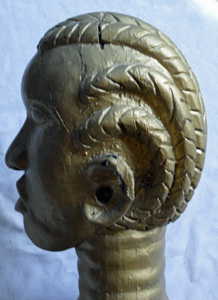Douglas Yaney Gallery
African Tribal Art www.douglasyaney.com © 1994-2018 All Rights Reserved |
|---|
Information
Home Page
Contact Us
About Us
About Collecting African Art
Purchasing Information
Reduced Prices
Reduced Prices- African Tribal Art , etc. <<<<<<<<
African Categories
Apparel, Clothing
Bowls, Containers & Bags
Drums & Musical Instruments
Fabrics, Cloth & other Weavings
Figures, Statues, Fetish
Game Boards
Jewelry, Necklace, Beads, Bracelets
Masks
Museum Quality Art
Neck Rests
Puppets
Staffs, Walking Sticks, Canes
Stools, Seats, Chairs
Utensils for Cooking & Medicine
Utilitarian Objects
Weapons, Shields
African Tribes (search by tribe)
Aku
Asante, Ashanti
Bacham
Baga
Baka
Bamana
Bamileke
Bamum
Bassa
Baule, Baoule
Bena Lulua, Lulua
Bidjogo
Bobo
Bongo
Borana
Bura
Chokwe, Jokwe, Tshokwe
Cross River
Dan
Dan - Bassa
Dinka
Dogon
Giryama
Guro
Gurunsi
HeHe
Hemba
Ibo, Igbo
Jokwe, Chokwe, Tshokwe
Karamojong, Karimojong
Kikuyu
Kissi
Kongo
Kuba
Kwere
Lega
Limba
Lobi
Loko
Luba
Luba - Songye, Luba-Songe
Luba - Zella
Lulua, Bena Lulua
Makonde
Makua
Maasai, Masai
Mende
Mossi
Ngbaka
Nok
Nupe
Nyamwezi
Nyankole, Nyancore, Nkole, Nkore, Ankole, Ankore
Paeda
Pende
Pokot
Rendille
Senufo
Sherbro
Sokoto
Songe, Songye
Songye - Luba
Sukuma
Temne
Tiv
Tshokwe, Chokwe, Jokwe
Turkana
Unidentified
Wobe
Yaka
YorubaHaitian Art
Paintings by Haitian Artists
More Art
Pre-Columbian Art
Resources
Museums with African Art Collections
African People of Importance
African Studies
Art Deco designs borrowed from African designs
Art & Artist Websites
Quality Links
Link to us, Link Partners
 |
designs borrowed from traditional African designs ? |
 |
|---|
Years ago when I was still living in Atlanta, I learned there was to be a talk given about the connection between Art Deco designs and African Art. I was already a huge fan of the clean geometric lines of the art deco style because when I was a kid in Fort Wayne, Indiana, I had adopted the Lincoln Tower  as my own personal favorite building. This beautiful sky scraper built in 1929 was my first introduction to the art deco style of architecture. This set me on a life long path of being drawn to any and all art deco designs in furniture, art, useful objects and most of all, architecture. I think my high school geometry teacher, Miss Lutie Young, also influenced my appreciation of clean cut, simple geometric shapes. Over the years I collected several pieces of art deco furniture and other objects that I found at antique fairs and flea markets.
as my own personal favorite building. This beautiful sky scraper built in 1929 was my first introduction to the art deco style of architecture. This set me on a life long path of being drawn to any and all art deco designs in furniture, art, useful objects and most of all, architecture. I think my high school geometry teacher, Miss Lutie Young, also influenced my appreciation of clean cut, simple geometric shapes. Over the years I collected several pieces of art deco furniture and other objects that I found at antique fairs and flea markets.
At the time of the announced lecture I was just starting to explore buying some African masks and figures. My interest was highly piqued, so I went to hear what the speaker had to say. The main thing I remember was the similarities in style. The woman who gave the talk had many photo slides showing African objects along side objects made during the Art Deco movement that started in the 1920s and on into the 1930s and 1940s. Seeing the beautiful designs side by side, it became quite evident that many of the art deco designs were borrowed directly from design elements of the much older traditional African carvings.
It is well documented that artists such as Picasso, Matisse, Giacometti and Braque were being influenced by African objects that they had access to early in their careers. Many of Picasso's faces appeared to have been painted using geometric shapes with traditional African masks as inspiration, thus creating a new style to be called cubism, so it makes perfect sense that some of the designers of art deco design were similarly inspired.
| Many of the design elements in the art deco buildings built in New York City in the 1930s were a direct result of the 1922 discovery of King Tutankhamen's tomb in one of the Egyptian pyramids. Many of the famous older skyscrapers of Manhattan were constructed during the Art Deco period. These are just a few examples including the Empire State Building, and the Chrysler Building. A video by Alan G. Wasenius What is Art Deco? Watch this video to learn more. Miami Beach Art Deco District
On a personal note: My first visit to New York City with friends took me from the Newark Airport, to the city by bus to the Port Authiority Bus Terminal, then a short walk to the old McGraw Hill Building to meet our host for the week-end. Not only was it a thrill to be in an incredible Art Deco building as you can see in the above film, but we also were told many stories about John Kennedy, Jr. from when he worked in that building. Stupid things like his mom would call to leave messages, but it was Jackie, so that made it exciting to us. |
|---|